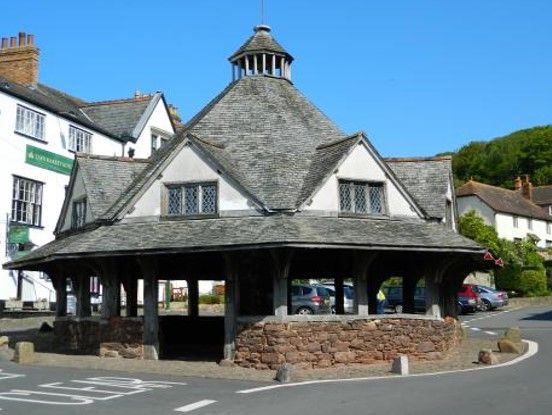On 11-12 February 2018, a precursor discussion to what is now Civic Revival was held at the Yarn Market Hotel in the village of Dunster, Somerset, at the edge of Exmoor national park. The meeting brought together Peter, Paul, Richard and Linda (now of Civic Revival), Hilary from Bexhill Town Team, and representatives from ‘Somerset Convergence’, an umbrella for green and new economy civic organisations in Somerset. We called the discussion ‘Beyond the Fragments – a discussion on a national network for place-based civic activists’. After the discussion we then went on a tour to look for examples of place-based civic activism, ably led by Antony Brunt of the Yarn Market Hotel, Dunster.
Dunster (pop. 800)
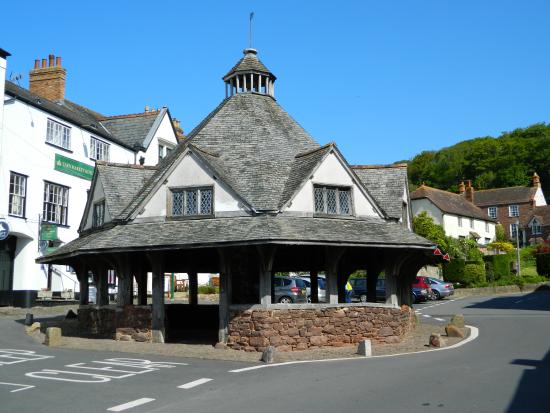
Our walking tour of Dunster reinforced what an extraordinarily special village it is. We visited the yarn market, tithebarn, the dovecote, the priory garden, the parish church, the castle gate, as well as the historic main streets. Alongside its beauty, Dunster’s ‘u.s.p.’ is a real sense of unbroken historic continuity, all the way through from feudal rural England.
With designation of the Exmoor National Park, and the passing of the castle and the farming estate from the Luttrell family (to the National Trust and the Crown Estate respectively) in a few short years in the 1950s, Dunster was simultaneously revolutionised and preserved. Although it is a constant effort to preserve the village’s built heritage, it is also a constant effort to preserve the community and way of life itself. Today, this also extends to keeping the tourist trade thriving and actively contributing to the economy of the village, and the local services it supports, such as the shops and pubs. Group travel – for walking, or choir singing, or craftwork – is one means by which visitors add to the village scene, rather than just consume it as car-borne ‘grockles’.
Watchet (pop. 3,800)
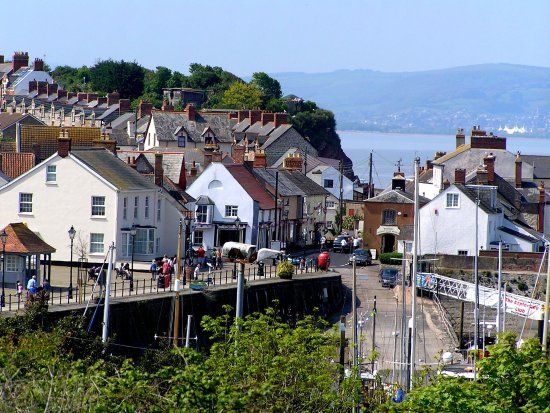
Antony then drove us in the hotel’s bus to Watchet, which is a very different kettle of fish. A historic harbour village (which minted coins for the kings of Wessex), Watchet became an industrial port dominated by the Wansbrough paper mill, which from origins in the 1750s was in continuous production until as recently as 2015. The valley bottom site has now been cleared and the town needs a new, more diversified economic and employment base. Despite being in rural Somerset, just a few miles from a national park, it actually resembles the small ex-industrial and mining ports of Wales or the North of England. I was reminded of Maryport, Cumberland and Amble, Northumberland.
With such a powerful employment shock, it inevitably has problems of social deprivation, but it also has a lot of assets, including a traditional small town centre with plenty of small independent shops, pubs, cafes, a working harbour, a promenade, a beach, and a strong claim to be the home port of Coleridge’s Ancient Mariner. The West Somerset steam railway station is right in the heart of the town, bringing trainloads of visitors in from Minehead or Bishop’s Lydeard (Taunton) to explore the place on foot. Although Dunster is much more the ‘chocolate box’ vision of ‘heritage’, Watchet is just as old, and has just as much heritage in its own way for the discerning visitor to appreciate. This has been recognised in the opening of a visitor centre and boat museum on the quayside in 2016 by the Onion Collective.
The way the community has rallied to save itself is a remarkable and admirable model of how ‘community-led regeneration’ can and should be conducted. The ‘Onion Collective’ Community Interest Company led by local businesswomen and sisters Naomi Griffith and Jessica Prendergrast is an extraordinary enterprise. The company’s mission statement on the website, reproduced below, could almost word-for-word serve as the mission statement for a Beyond the Fragments network:
We believe that every community has the power to build a strong and secure future for itself. Times have changed, and it is no longer possible to rely on local authorities to ensure community sustainability.
We help communities build a plan for their hometown and we help them to deliver it. That plan includes a process of asking what is needed, defining shared community priorities and then helping to ensure success whether it is a major capital build or revenue projects. This process has proven to be transformative.
Regeneration from the roots up enables communities to feel that they are instrumental in making where they live the place they want it to be. It nurtures pride, tackles loneliness, gives a sense of purpose and belief. We work with communities to help make them the best versions of themselves.
We only had time for a flying visit to visit the Onion Collective’s ‘Contains Art’ project on the harbour East Quay, where local artists and makers can take space in old shipping containers for workshop and retail purposes. We spoke briefly to project manager Jon Barrett. Contains Art is a ‘meanwhile use’ for the wider East Quay community-led regeneration scheme.
Reassuringly for those of us for whom the journey is as much fun as the destination, the battle to revive local pride and identity is not completely won yet. The visitor centre and boat museum is a superb conversion of an old goods shed belonging to the Bristol and Exeter Railway, one of two railway companies built in Victorian Watchet. It proudly flies the red wyvern rampant of Somerset, the county flag, a coat of arms reputedly worn by King Arthur himself. I asked the local teenagers hanging out in the promenade shelter, who were enlivening their half term by teasing tourists, what the flag was. “Dunno – Liverpool Football Club?” came the reply.
Minehead (pop. 12,000)
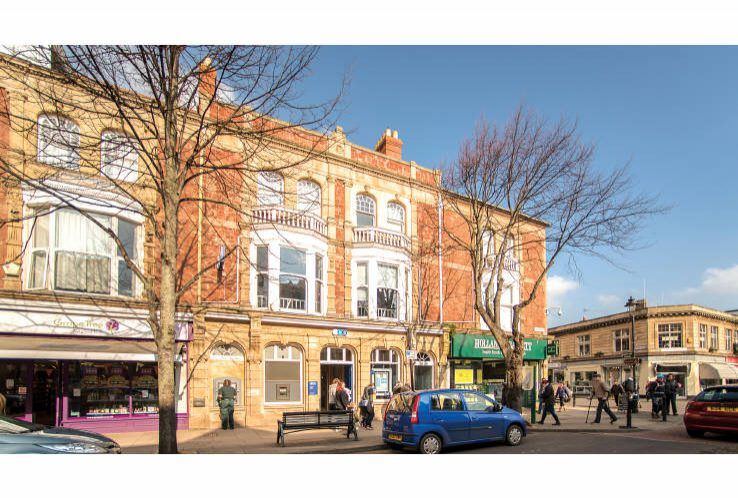
We finished our tour at Minehead. Minehead is a traditional small seaside resort which also serves as the main retail centre for Exmoor and the West Somerset district. Although it shares many characteristics with other British seaside resorts, Minehead’s core business of budget ‘bucket and spade’ holidays appears to be in better shape than in many other similar places. The huge Butlins holiday park has received a big facelift and is in rude good health. A good number of traditional seaside hotels and guest houses are still going in the town, and others have converted into old people’s homes, or residential flats.
Although Minehead has a reputation as a budget resort now, there is much evidence this wasn’t always the case. The Parade, the main shopping street, retains an elegant look, and The Avenue, running down to the Esplanade is a very attractive street that reminded us a little of Southport’s Lord Street. The ‘Higher Town’, clinging to the slopes of the North Hill, with its quaint cottages and grand villas is very much ‘des res’. The Exmoor National Park starts right at the edge of the Higher Town, as does the 630 mile South West Coast Path national trail.
The coast of Glamorgan and the giant Aberthaw power station can clearly be seen only 10 miles across the Bristol Channel. But the Bristol Channel’s huge tidal range (the world’s second highest) means that the old harbour is only accessible to ships for two hours on either side of each high tide, and this makes the scheduling of regular passenger ferries too difficult. Yet, although there are no longer any passenger steamers from South Wales, and Cardiff is a 90+ mile drive away, a surprising proportion of Minehead’s visitors still come from Wales.
It’s very difficult to judge a seaside resort from a brief visit on a cold February day, but my sense was that Minehead has less of the air of melancholy and decay that pervades many British seaside towns. Thanks to Butlins, its basic raison d’etre continues.
But, like any British seaside resort, it struggles with poverty, seasonal income, and demands on services as an ageing population becomes an increasingly geriatric one. Small hospitality businesses like cafes and hotels desperately need more revenue and more investment for the steady modernisation and upgrade of the facilities, whilst on the edge of town, a large superstore “trucks the goods in and the money out”, in the words of Professor Karel Williams. Caring for the old could be a really fulfilling career, and Minehead could be a great place to age well and live out your dotage in dignity, but money is the missing ingredient needed to make it happen.
We looked for evidence of civic activism. On The Avenue, a sign invited us to help MineheadConnect to “restore this old hospital as a community facility”. The red sandstone buildings are very fine and before being a hospital housed the town’s Assembly Rooms. The plan is to make a “a very sensitive and sympathetic restoration of the heritage parts of the site to their original ‘assembly rooms’ format… to create a high quality, long term sustainable community ‘hub’, providing flexible and adaptable space to host a variety of community activities, functions and services, together with four residential apartments for the affordable letting market.” A very worthy project.
In the leaflet rack at the Apple Tree Tea Rooms (“#1 out of 80 places to eat in Minehead – Trip Advisor”), we were invited by the Minehead Swimming Pool Community Interest Company to share the dream of building a new swimming pool for the town. Rather than donate directly, people are invited to play the Somerset West Lottery, a new venture set up in 2017 by Taunton Deane and West Somerset District Councils, where 40p of each £1 weekly ticket goes to prizes and 60p to local good causes. What a great idea, to disband the National Lottery, and replace it with small local ones.
West Somerset Railway
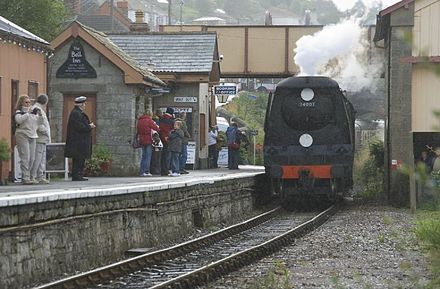
The write up of a visit to West Somerset to discuss place-based civic activism would not be complete without an honourable mention to what is an astonishing achievement of third sector enterprise: the West Somerset Railway (WSR). The WSR runs from Minehead via Dunster and Watchet to Bishop’s Lydeard, four miles from Taunton.
The railway was closed by British Rail in 1971 as part of the Beeching closure programme, but, in one of those remarkable stories from the 1970s era of railway preservation enthusiasm, the line was reopened over the period 1976 to 1979 by private voluntary enterprise. The WSR is now one of Britain’s longest and most popular heritage steam railways, carrying over 200,000 passengers per year. Trains run on 243 days of the year, including the week of February school half term when we visited. The WSR employs 50 paid staff and 900 volunteers.
The WSR already plays a major part in the life of the three places. It has beautifully conserved stations in the middle of town at Minehead and Watchet, and between the village and the beach at Dunster. For most of its passengers, its role is more to provide a visitor experience/activity forming part of the holiday than purely to be a transport link. The main public transport link between Minehead and Taunton is the half hourly no. 28 bus. (Having said that, all of us in the Beyond the Fragments group were able to travel to or from Lancashire, Sussex and London to the Yarn Market Hotel, partly by steam train.)
There is now a campaign to extend the hourly Cardiff-Taunton train from Taunton to Bishop’s Lydeard, which would permit National Rail passengers to access the steam railway directly. Some trains might work all the way through to Minehead. This is felt to be more feasible than permitting the WSR’s steam trains to run along the main line to Taunton station. Whatever the economics of this idea, the concept that the WSR can continue to play a key part in the life of the area, including the revival of Watchet, is a sound one. Getting tourists to explore the line in detail, perhaps linked to walking or cycling the local area, is a great way to support local businesses. Such tourists are likely to spend more per head in the local economy than car-borne tourists passing through. The WSR is very much alive to its wider role in the local area, and intelligent steps to develop this role further should be applauded.
Last thought
On a quick half-day’s tour of three West Somerset places, we scratched the surface of a very impressive range of local initiatives that we could define as place-based civic activism. On the website of Minehead’s Apple Tree Tea Room at www.appleontheavenue.co.uk can be found a statement that could serve as the vision for place-based civic activism everywhere; the aim to achieve:
“a fusion of what was, what is, and belief in what might yet come to pass”.

